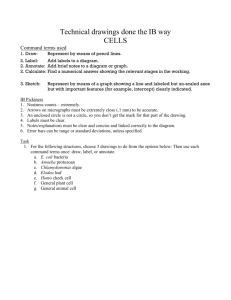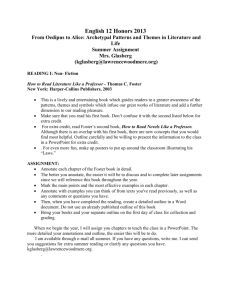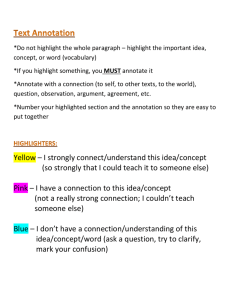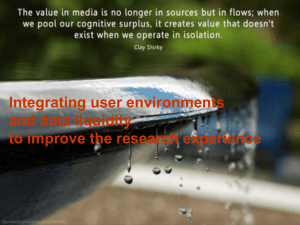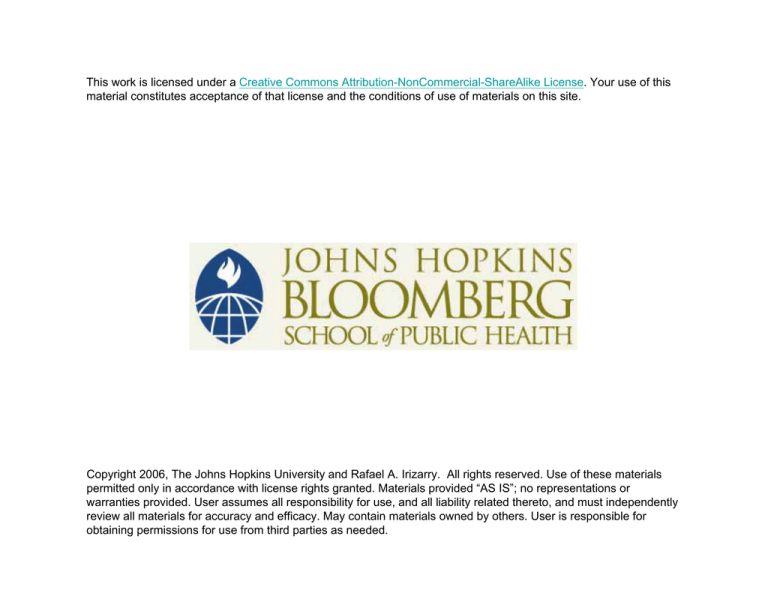
This work is licensed under a Creative Commons Attribution-NonCommercial-ShareAlike License. Your use of this
material constitutes acceptance of that license and the conditions of use of materials on this site.
Copyright 2006, The Johns Hopkins University and Rafael A. Irizarry. All rights reserved. Use of these materials
permitted only in accordance with license rights granted. Materials provided “AS IS”; no representations or
warranties provided. User assumes all responsibility for use, and all liability related thereto, and must independently
review all materials for accuracy and efficacy. May contain materials owned by others. User is responsible for
obtaining permissions for use from third parties as needed.
BIOINFORMATICS AND COMPUTATIONAL
BIOLOGY SOLUTIONS USING R AND
BIOCONDUCTOR
Biostatistics 140.688
Rafael A. Irizarry
Annotation
Annotation
• One of the largest challenges in analyzing genomic
data is associating the experimental data with the
available biological metadata, e.g., sequence, gene
annotation, chromosomal maps, literature.
• And making that data available for computation
• Bioconductor provides three main packages for this
purpose:
– annotate (end-user);
– AnnBuilder (developer)
– annaffy (end-user – will see a name change)
1
WWW resources
•
•
•
•
•
•
•
•
Nucleotide databases: e.g. GenBank.
Gene databases: e.g. Entrez Gene, UniGene.
Protein sequence and structure databases: e.g. SwissProt,
Protein DataBank (PDB).
Literature databases: e.g. PubMed, OMIM.
Chromosome maps: e.g. NCBI Map Viewer.
Pathways: e.g. KEGG.
Entrez is a search and retrieval system that integrates
information from databases at NCBI (National Center for
Biotechnology Information).
if you know of some we should be using – please let us know
annotate:
annotate: matching IDs
Important tasks
• Associate manufacturers or in-house probe
identifiers to other available identifiers.
E.g.
Affymetrix IDs Entrez Gene IDs
Affymetrix IDs GenBank accession number.
• Associate probes with biological data such as
chromosomal position, pathways.
• Associate probes with published literature data via
PubMed (need PMID).
annotate:
annotate: matching IDs
Affymetrix identifier
HGU95A chips
Entrez Gene ID
“41046_s_at”
GenBank accession
#
Gene symbol
“X95808”
PubMed, PMID
“10486218”
“9205841”
“8817323”
“X”, “Xq13.1”
Chromosomal
location
“9203”
“ZNF261”
2
Annotation data packages
•
The Bioconductor project provides annotation
data packages, that contain many different
mappings to interesting data
– Mappings between Affy IDs and other probe IDs:
hgu95av2 for HGU95Av2 GeneChip series, also,
hgu133a, hu6800, mgu74a, rgu34a, YG.
– Affy CDF data packages.
– Probe sequence data packages.
•
These packages are updated and expanded
regularly as new data become available.
• They can be downloaded from the Bioconductor
website and also using installDataPackage.
• DPExplorer: a widget for interacting with data
packages.
• AnnBuilder: tools for building annotation data
packages.
annotate:
annotate: matching IDs
•
•
•
•
•
•
Much of what annotate does relies on matching symbols.
This is basically the role of a hash table in most
programming languages.
In R, we rely on environments.
The annotation data packages provide R environment
objects containing key and value pairs for the mappings
between two sets of probe identifiers.
Keys can be accessed using the R ls function.
Matching values in different environments can be
accessed using the get or multiget functions.
annotate:
annotate: matching IDs
> library(hgu95av2)
> get("41046_s_at", env = hgu95av2ACCNUM)
[1] "X95808”
> get("41046_s_at", env = hgu95av2LOCUSID)
[1] "9203”
> get("41046_s_at", env = hgu95av2SYMBOL)
[1] "ZNF261"
> get("41046_s_at", env = hgu95av2GENENAME)
[1] "zinc finger protein 261"
> get("41046_s_at", env = hgu95av2SUMFUNC)
[1] "Contains a putative zinc-binding
motif (MYM)|Proteome"
> get("41046_s_at", env = hgu95av2UNIGENE)
[1] "Hs.9568"
3
annotate:
annotate: matching IDs
> get("41046_s_at", env =
[1] "X"
> get("41046_s_at", env =
X
-68692698
> get("41046_s_at", env =
[1] "Xq13.1”
> get("41046_s_at", env =
[1] "10486218" "9205841"
get("41046_s_at", env =
TAS
TAS
"GO:0003677" "GO:0007275"
hgu95av2CHR)
hgu95av2CHRLOC)
hgu95av2MAP)
hgu95av2PMID)
"8817323"
hgu95av2GO)
IEA
"GO:0016021"
annotate:
annotate: matching IDs
• Instead of relying on the general R
functions for environments, new userfriendly functions have been written for
accessing and working with specific
identifiers.
• E.g. getGO, getGOdesc, getLL,
getPMID, getSYMBOL.
annotate:
annotate: matching IDs
> getSYMBOL("41046_s_at",data="hgu95av2")
41046_s_at
"ZNF261"
> gg<- getGO("41046_s_at",data="hgu95av2")
> getGOdesc(gg[[1]], "MF")
$"GO:0003677"
"DNA binding activity"
> getLL("41046_s_at",data="hgu95av2")
41046_s_at
9203
> getPMID("41046_s_at",data="hgu95av2")
$"41046_s_at"
[1] 10486218 9205841 8817323
4
annotate:
annotate: querying databases
The annotate package provides tools for
• Searching and processing information from
various WWW biological databases
– GenBank,
– LocusLink,
– PubMed.
• Regular expression searching of PubMed
abstracts.
• Generating nice HTML reports of analyses,
with links to biological databases.
annotate:
annotate: WWW queries
• Functions for querying WWW databases from
R rely on the browseURL function
browseURL("www.r-project.org")
Other tools: HTMLPage class, getTDRows,
getQueryLink, getQuery4UG, getQuery4LL,
makeAnchor .
• The XML package is used to parse query
results.
annotate:
annotate: querying GenBank
www.ncbi.nlm.nih.gov/Genbank/index.html
• Given a vector of GenBank accession
numbers or NCBI UIDs, the genbank function
– opens a browser at the URLs for the
corresponding GenBank queries;
– returns an XMLdoc object with the same data.
genbank(“X95808”,disp=“browser”)
h ttp://www.ncbi.nih.gov/entrez/query.fcgi?tool=bioconductor&cmd=Search&db=Nucleotide&term=X95808
genbank(1430782,disp=“data”,
type=“uid”)
5
annotate:
annotate: querying LocusLink
www.ncbi
www.ncbi..nlm.
nlm.nih.
nih.gov/LocusLink/
• locuslinkByID: given one or more LocusIDs,
the browser is opened at the URL corresponding
to the first gene.
locuslinkByID(“9203”)
http://www.ncbi.nih.gov/LocusLink/LocRpt.cgi?l=9203
• locuslinkQuery: given a search string, the
results of the LocusLink query are displayed in
the browser.
locuslinkQuery(“zinc finger”)
http://www.ncbi.nih.gov/LocusLink/list.cgi?Q=zinc finger&ORG=Hs&V=0
• getQuery4LL.
annotate:
annotate: querying PubMed
www.ncbi.nlm.nih.gov
• For any gene there is often a large
amount of data available from PubMed.
• The annotate package provides the
following tools for interacting with
PubMed
– pubMedAbst: a class structure for PubMed
abstracts in R.
– pubmed: the basic engine for talking to
PubMed (pmidQuery).
annotate:
annotate: pubMedAbst class
Class structure for storing and processing
PubMed abstracts in R
• pmid
• authors
• abstText
• articleTitle
• journal
• pubDate
• abstUrl
6
annotate:
annotate: high-level tools for
querying PubMed
• pm.getabst: download the specified PubMed
abstracts (stored in XML) and create a list of
pubMedAbst objects.
• pm.titles: extract the titles from a list of
PubMed abstracts.
• pm.abstGrep: regular expression matching
on the abstracts.
annotate:
annotate: PubMed example
pmid <-get("41046_s_at", env=hgu95aPMID)
pubmed(pmid, disp=“browser”)
http://www.ncbi.nih.gov/entrez/query.fcgi?tool=bioconductor&cmd=Retrieve&db=PubMed&list_uids=
10486218%2c9205841%2c8817323
absts <- pm.getabst(“41046_s_at”, base=“hgu95a”)
pm.titles(absts)
pm.abstGrep("retardation",absts[[1]])
annotate:
annotate: PubMed HTML report
• The new function pmAbst2HTML takes a
list of pubMedAbst objects and
generates an HTML report with the titles
of the abstracts and links to their full
page on PubMed.
pmAbst2HTML(absts[[1]],
filename="pm.html")
7
pmAbst2html
function from
annotate package
pm.html
annotate:
annotate: analysis reports
• A simple interface, htmlpage, can be used to
generate an HTML report of analysis results.
• The page consists of a table with one row per
gene, with links to Entrez Gene, Affymetrix,
SwissProt, UniGene, or OMIM.
• Entries can include various gene identifiers
and statistics.
htmlpage
function from
annotate
package
genelist.html
8
annaffy
• Provides simplified mappings between
Affymetrix IDs and annotation data
• Relies on chip-level annotation packages
created by AnnBuilder
• Supplies functions to produce mappings for
almost all environments in a given annotation
package
annaffy:Interactive
annaffy:Interactive
> symbol <- aafSymbol(probids, "hgu95av2")
> getText(symbol)
[1] "COL11A2" "FLT3" "BDNF" "CD19" "GSTT2" "FGFR2" "IL18"
[8] "IFNB1" "RAB5B" "TAF11"
> gos <- aafGO(probids, "hgu95av2")
> gos[[3]]
An object of class "aafGO"
[[1]]
An object of class "aafGOItem"
@id "GO:0007399"
@name "neurogenesis"
@type "Biological Process"
@evid "TAS"
annaffy:Interactive
annaffy:Interactive
> gbs <- aafGenBank(probids, "hgu95av2")
> getURL(gbs[[3]])
[1]
"http://www.ncbi.nlm.nih.gov/entrez/query.fcgi?cmd=search&db=nucleoti
de&term=M61176%5BACCN%5D&doptcmdl=GenBank"
> browseURL(getURL(gbs[[3]]))
This will open a browser pointing to this particular GenBank ID
9
annaffy:Non-interactive
annaffy:Non-interactive
• Primary function of annaffy is to
produce very nice HTML or text tables
• These tables can contain:
– Links to databases
– Statistics
– Expression measures
• Color-coded to intensity for easy viewing
annaffy:HTML
annaffy:HTML Table
> aaf.handler()
[1] "Probe"
[4] "Function"
[7] "GenBank"
[10] "UniGene"
[13] "Pathway"
"Symbol"
"Description"
"Chromosome"
"Chromosome Location"
"LocusLink"
"Cytoband"
"PubMed"
"Gene Ontology"
> anntable <- aafTableAnn(probids[1:10], "hgu95av2", aaf.handler()[c(1:3,
10)])
> stattable <- aafTable("t-stat" = rnorm(10), "p-value" = runif(10))
> exprtable <- aafTableInt(aafExpr, probeids = probids[1:10])
> table <- merge(anntable, stattable)
> table <- merge(table, exprtable)
> saveHTML(table, "faketable.HTML", title="Some Fake Results")
10
What is GO?
• The Gene Ontology Consortium
coordinates the development and
refinement of GO
• GO is a set of three ontologies for
gene products
– molecular function
– cellular component
– biological process
Data
• as part of Bioconductor we provide a GO
package which has all the GO specific data
– terms and relationships
– some whole species data
• for each instrument (chip) we provide chip
specific data
– maps from the probes to GO terms
– counts of probes per GO term + children
• constantly evolving and being updated
KEGG
• Kyoto Encyclopedia of Genes and
Genomes
• Database of pathway information
• Not many genes are annotated to
pathways yet
11
Statistics on Annotation
• Very little pathway information
• Use GO terms as a surrogate (primarily
the Molecular Function and Biological
Process terms)
• Use Fisher’s Exact test
• GOstats package
Fisher’
Fisher’s Exact
Significant
Not Significant
8
19
215
12383
Apoptosis
Not Apoptosis
GOstats:graphing
GOstats:graphing
• The GOstats package can also be used
to produce graphics to visualize various
pathways
– GO directed acyclic graph (DAG)
– KEGG pathway
12
ALL Example
MF Graph
CoCiteStats
• Infer interrelatedness between genes
using PubMed
• Again, based on the idea of a two way
table
CoCiteStats
Cite gene 1
Don’t cite gene 1
8
19
14
12584
Cite gene 2
Don’t cite gene 2
13
CoCiteStats:statistics
CoCiteStats:statistics
Cite gene 1
Don’t cite gene 1
n11
n12
Cite gene 2
n21
n22
Don’t cite gene 2
CoCiteStats:statistics
CoCiteStats:statistics
•
•
•
•
Concordance (n11)
Jaccard Index (n11/n11 + n12 + n21)
Hubert’s gamma
p-values by permutation for all statistics
14

